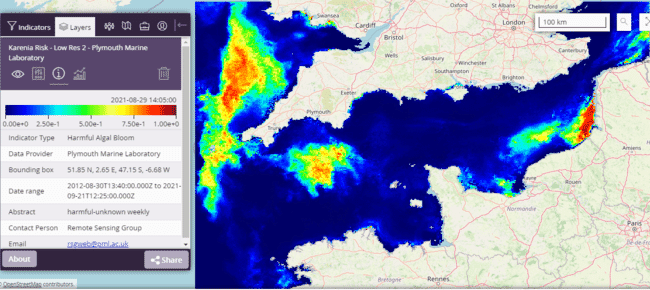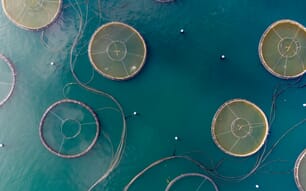
The system currently covers Karenia mikimotoi (can reduce oxygen in the water column), Phaeocystis globosa (produces foam and can smother the seabed and clog fish gills) and Pseudo-nitzschia (responsible for amnesic shellfish poisoning). © Plymouth Marine Laboratory
In the EU, the annual cost of HABs is estimated to be in excess of £800 million and current methods of tracking HABs in the English Channel are expensive, costing nearly £2 million annually to monitor just 6 percent of the Channel.
Combining data from four shellfish farms in southwest England, the potential weekly loss in sales due to HABs could range between £26,350 and £100,000. These costs were based on the selling price of mussels and the weekly quantity produced during summertime in the UK, but do not include the cost of recalling the mussels if they have already been dispatched. Recalling 1 tonne of mussels in the UK can cost around £160.
As such, there is much research being undertaken around the world to help mitigate the extensive financial, social and environmental impacts of HABs. One such collaborative research project is the INTERREG-VA project S-3 EUROHAB, which is a collaboration between France and England to investigate how satellite imagery can complement the monitoring of HABs and increasingly high levels of nutrients (eutrophication) to support marine management.
Over the last five years, the project team have used data from the European Space Agency’s (ESA) Copernicus Sentinel 3 satellite and other sources to track HABs and examine water quality to feed into the development of a cost-effective, rapid and user-friendly web-based alert system; a first-of-its-kind tool to help monitor the growth and spread of HABs.
The running cost of the alert system is estimated to be only £37,000 per year to cover the entire English Channel and will determine the risk of some HAB species based on their abundance in the surface waters.
The system currently covers the species Karenia mikimotoi (can reduce oxygen in the water column), Phaeocystis globosa (produces foam and can smother the seabed and clog fish gills) and Pseudo-nitzschia (responsible for amnesic shellfish poisoning). The project also conducted research into detecting Dinophysis sp. (produces diarrhetic shellfish toxins) and Lepidodinium chlorophorum (associated with mass mortalities of fish and cultured bivalves) from space.
Another significant part of this collaborative project was to bring together in situ mooring and satellite data from multiple sources on both sides of the English Channel, to enable the assessment of the environmental factors that lead to HABs and validate the HAB risk map within the web-based alert system. The data collated included temperature, salinity, nutrients, chlorophyll-a (Chl-a), phytoplankton counts (including HAB species), dissolved oxygen, turbidity, surface solar irradiance and wind speed.
The S-3 EUROHAB team worked closely with over 70 end-users, decision-makers and other interest-holders to help ensure the developed alert system is a meaningful step forward in HAB monitoring. Interest-holders helped inform aspects such as alert frequency, seasonality and ground sample size through a series of stakeholder workshops as well as highlight other factors that would be helpful, such as air temperature, water transparency, currents and river plume modelling. 10 alert system demos were also conducted with end-users and these will continue to be available on request.
The research from this project was well received at last year’s COP26 climate change event in Glasgow, and the team are currently exploring the efficacy of the water quality algorithms under extreme conditions as well as completing research into its transferability to other regions.
Lead scientists on the project, Dr Gavin Tilstone of Plymouth Marine Laboratory, said in a press release: “It was great working on a collaborative project with French partners with such a wealth of expertise. The web alert system has assembled an array of products to aid marine managers, monitoring organisations and shellfish farmers to help track harmful algal blooms and water quality in the English Channel.”
A project partner commented: “Good use of satellite technology to help track blooms that is a real benefit to monitoring organisations.”
An end-user fed back: “The research and development on new HAB algorithms will benefit both shellfish organisations and marine management in being able to track the blooms at high resolution.”
The final version of the S-3 EUROHAB web alert system can be found at www.s3eurohab.eu/portal. A French demo of using the web alert system can be found at https://www.youtube.com/watch?v=dHWlAXrxMjM.
Feedback from new users would be very welcome, so if you have any comments then please contact Dr Gavin Tilstone on ghti@pml.ac.uk




